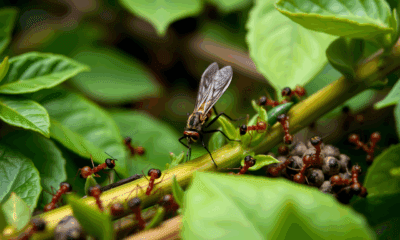While we try to keep things accurate, this content is part of an ongoing experiment and may not always be reliable.
Please double-check important details — we’re not responsible for how the information is used.
Anthropology
Uncovering Ancient Human Behavior: The Secret Lives of Fossil Hands
Scientists have found new evidence for how our fossil human relatives in South Africa may have used their hands. Researchers investigated variation in finger bone morphology to determine that South African hominins not only may have had different levels of dexterity, but also different climbing abilities.

Animals
Unveiling the Ancient Secrets of the Dirt Ant: A 16-million-year-old Fossil Reveals the Smallest Predator Ant Ever Found
A fossilized Caribbean dirt ant, Basiceros enana, preserved in Dominican amber, reveals the species ancient range and overturns assumptions about its size evolution. Advanced imaging shows it already had the camouflage adaptations of modern relatives, offering new insights into extinction and survival strategies.
Ancient Civilizations
Unraveling a 130-Year-Old Literary Mystery: The Song of Wade Finally Solved
After baffling scholars for over a century, Cambridge researchers have reinterpreted the long-lost Song of Wade, revealing it to be a chivalric romance rather than a monster-filled myth. The twist came when “elves” in a medieval sermon were correctly identified as “wolves,” dramatically altering the legend’s tone and context.
Ancient Civilizations
Uncovering Ancient Histories: Princeton Study Reveals 200,000 Years of Human-Neanderthal Interbreeding
For centuries, we’ve imagined Neanderthals as distant cousins — a separate species that vanished long ago. But thanks to AI-powered genetic research, scientists have revealed a far more entangled history. Modern humans and Neanderthals didn’t just cross paths; they repeatedly interbred, shared genes, and even merged populations over nearly 250,000 years. These revelations suggest that Neanderthals never truly disappeared — they were absorbed. Their legacy lives on in our DNA, reshaping our understanding of what it means to be human.
-

 Detectors7 months ago
Detectors7 months agoA New Horizon for Vision: How Gold Nanoparticles May Restore People’s Sight
-

 Earth & Climate8 months ago
Earth & Climate8 months agoRetiring Abroad Can Be Lonely Business
-

 Cancer7 months ago
Cancer7 months agoRevolutionizing Quantum Communication: Direct Connections Between Multiple Processors
-

 Albert Einstein8 months ago
Albert Einstein8 months agoHarnessing Water Waves: A Breakthrough in Controlling Floating Objects
-

 Diseases and Conditions8 months ago
Diseases and Conditions8 months agoReducing Falls Among Elderly Women with Polypharmacy through Exercise Intervention
-

 Chemistry7 months ago
Chemistry7 months ago“Unveiling Hidden Patterns: A New Twist on Interference Phenomena”
-

 Earth & Climate7 months ago
Earth & Climate7 months agoHousehold Electricity Three Times More Expensive Than Upcoming ‘Eco-Friendly’ Aviation E-Fuels, Study Reveals
-

 Agriculture and Food8 months ago
Agriculture and Food8 months ago“A Sustainable Solution: Researchers Create Hybrid Cheese with 25% Pea Protein”





























